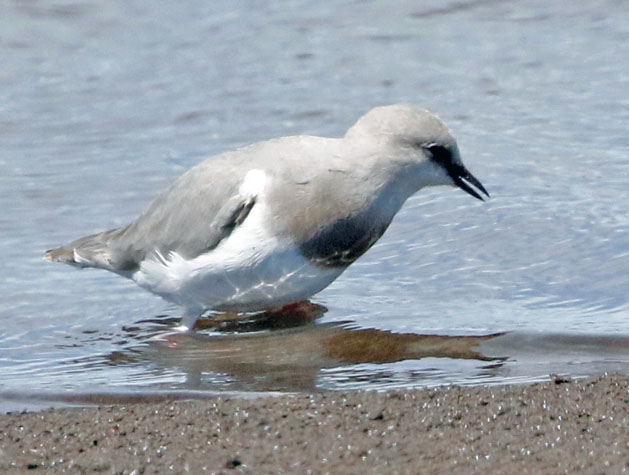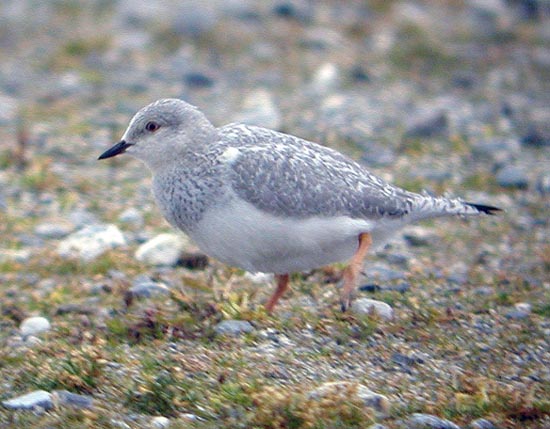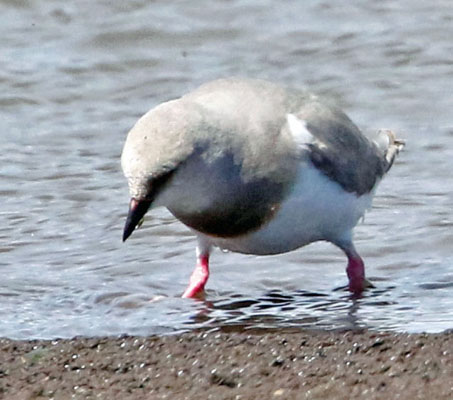
a web page by Don Roberson |
 |
MAGELLANIC PLOVER Pluvianellidae |
|
 The Magellanic Plover is an enigmatic shorebird confined to the southern tip of South America (above and left). Traditionally included among the plovers [Charadriidae], it is an odd, almost dove-shaped wader that behaves more like a turnstone than anything else, but is unique in many aspects of its ecology. It has a number of features not shared with other plovers, including the habit of turning seaweed and stones to uncover invertebrates, and digging in the sand with its short legs for buried prey. It breeds around shallow saline lakes with shores laden with salt deposits in Tierra del Fuego. Small flocks disperse more widely in the non-breeding season, reaching coastal lagoons in Chile and Argentina (Piersma 1996, Jaramillo 2003, Imberti & Matus 2023). Research into morphological and osteological characters provided initial evidence that this was not a plover but, rather, more closely linked to sheathbills [Chionidae] than any other Charadriformes (Strauch 1978, Chu 1995). Genetic data (Paton et al. 2003) support this relationship. The Magellanic Plover is an enigmatic shorebird confined to the southern tip of South America (above and left). Traditionally included among the plovers [Charadriidae], it is an odd, almost dove-shaped wader that behaves more like a turnstone than anything else, but is unique in many aspects of its ecology. It has a number of features not shared with other plovers, including the habit of turning seaweed and stones to uncover invertebrates, and digging in the sand with its short legs for buried prey. It breeds around shallow saline lakes with shores laden with salt deposits in Tierra del Fuego. Small flocks disperse more widely in the non-breeding season, reaching coastal lagoons in Chile and Argentina (Piersma 1996, Jaramillo 2003, Imberti & Matus 2023). Research into morphological and osteological characters provided initial evidence that this was not a plover but, rather, more closely linked to sheathbills [Chionidae] than any other Charadriformes (Strauch 1978, Chu 1995). Genetic data (Paton et al. 2003) support this relationship. |
 The breeding biology of Magellanic Plover was first studied in some detail by Jehl (1975); ecology and habitat selection was investigated by Lishman & Nol (2012). From a conservation standpoint, it was considered to be "safe," due to the remoteness and mostly pristine condition of the areas it inhabits. However, a concerted effort to count the breeding population in December 2021 — surveying 180 sites in southern Argentina and Chile — located only 264 adults. This was far fewer than even the most pessimist predictions of its population size. A follow-up survey in the non-breeding season (May 2022) found only 300 birds, and 55 of them were juveniles, all born since the December 2021 census (photo of juvenile, right, by Alvaro Jaramillo). These shockingly low numbers could place this species on the critically endangered list! (Imberti & Matus 2023). The breeding biology of Magellanic Plover was first studied in some detail by Jehl (1975); ecology and habitat selection was investigated by Lishman & Nol (2012). From a conservation standpoint, it was considered to be "safe," due to the remoteness and mostly pristine condition of the areas it inhabits. However, a concerted effort to count the breeding population in December 2021 — surveying 180 sites in southern Argentina and Chile — located only 264 adults. This was far fewer than even the most pessimist predictions of its population size. A follow-up survey in the non-breeding season (May 2022) found only 300 birds, and 55 of them were juveniles, all born since the December 2021 census (photo of juvenile, right, by Alvaro Jaramillo). These shockingly low numbers could place this species on the critically endangered list! (Imberti & Matus 2023). |
| Family level status for Magellanic Plover is still somewhat controversial. Dickinson (2003) includes Magellanic Plover among the sheathbills in Chionidae, as have some others. It has been said that the elevation of Magellanic Plover to its own family was a Sibley & Monroe (1990) innovation, but this is not quite true. Sibley & Monroe (1990) listed it almost dead-center among the plovers in family Charadriidae, and cited only Jehl (1975) for its placement. However, Charles Sibley (1996) elevated it to family status in his diskette update to Sibley & Monroe after Burt Monroe's death. Yet even that text acknowledged that the suggestion was not based on biochemical evidence (unlike all their other DNA-DNA hybridization work) but instead was grounded in its unique behavioral characteristics. Sibley's suggestion was entirely philosophical: "Placing it in a monotypic family calls attention to its unique or unusual features and may attract additional study." Piersma (1996), in the Handbook of the Birds of the World series, did not. It is only the more recent biochemical evidence (Paton et al. 2003) that now better supports what might been a seemingly premature family designation in the 1990s. |
Despite their remoteness, the high-elevation shallow lagoons used for breeding are subject to water level changes, a factor that may have become crucial recently during several very dry decades (Imberti & Matus 2023). It shares this habitat with another southern enigma, the endangered Hooded Grebe Podiceps gallardoi, whose population is also in decline. It is not easy to reach its breeding lagoons in Patagonia. The roads are atrocious, the weather in mid-summer is cold, and high winds blow constantly. But the ever-changing nature of the habitat — with breeding lagoons one year becoming dry and useless by the following year — adds to the problems. We saw this wonderful bird in November 2022, but not without a struggle against 40 mile-an-hour gusts from one dry lagoon to the next until the fourth one along still had water (and, by good fortune, also Hooded Grebe!). Concern about the fate of Hooded Grebe and Magellanic Plover is just now reaching global consciousness. There are now local teams in Argentina and Chile that are focused on these Patagonian endemics. Long may the Magellanic Plover search the shores of shallow lagoons at the end of the map! (below, with Baird's Sandpiper). |
 |
Photos: My photos of adult Magellanic Plover Magellanic Plover Pluvianellus socialis were taken on the Stroebel Plateau, Santa Cruz Province, Argentina, on 15 Nov 2022 (where it was my final bird family). The juv Magellanic Plover was taken by Alvaro Jaramillo at Laguna de los Cisnes, Tierra del Fuego, Chile, on 31 Jan 2004. Photos © Don Roberson and © Alvaro Jaramillo, and used with permission; all rights reserved. Bibliographic note: There is no "family book" for Magellanic Plover but an introduction is in Piersma (1996). Literature cited:
|
 The Magellanic Plover breeds on high-elevation lakes in Patagonia in the austral spring (Sep-Nov; left). Pairs are solitary and defend territories vigorously. Generally two eggs are laid, and incubated by both parents, but if both hatch, the weaker check usually does not survive (Jehl 1975). Magellanic Plovers carry food to their chicks in the crop, a pouch which can also be distended in display (Piersma 1996).
The Magellanic Plover breeds on high-elevation lakes in Patagonia in the austral spring (Sep-Nov; left). Pairs are solitary and defend territories vigorously. Generally two eggs are laid, and incubated by both parents, but if both hatch, the weaker check usually does not survive (Jehl 1975). Magellanic Plovers carry food to their chicks in the crop, a pouch which can also be distended in display (Piersma 1996).